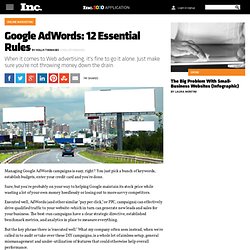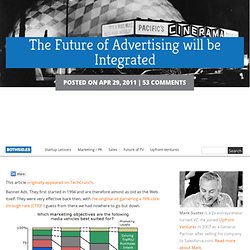

Google AdWords: 12 Essential Rules. Managing Google AdWords campaigns is easy, right?

You just pick a bunch of keywords, establish budgets, enter your credit card and you're done. Sure, but you're probably on your way to helping Google maintain its stock price while wasting a lot of your own money heedlessly or losing out to more savvy competitors. Executed well, AdWords (and other similar "pay per click," or PPC, campaigns) can effectively drive qualified traffic to your website–which in turn can generate new leads and sales for your business.
The best-run campaigns have a clear strategic directive, established benchmark metrics, and analytics in place to measure everything. But the key phrase there is "executed well. " If you're managing your own PPC campaign in-house, make sure you understand these essential rules. 1. 2. You need to think about your PPC campaign as a direct-response experience.
Instead, steer them more clearly into the response you want by creating a unique "landing page. " World's Largest In-Image Advertising Platform. The Future of Advertising will be Integrated. This article originally appeared on TechCrunch.

Banner Ads. They first started in 1994 and are therefore almost as old as the Web itself. They were very effective back then, with the original ad garnering a 78% click-through rate (CTR)! I guess from there we had nowhere to go but down. Nowadays banner ads get on average 0.2% CTR meaning for every 1,000 ads that are served up only 2 people click on them. Holy Shiitake! Despite its creation more than 15 years ago, banner ads have been surprisingly resilient despite their lack of efficacy. The fundamental problem with banner ads is a condition called “banner blindness” meaning that our eyes are really quickly trained to look at what is most relevant on the page – the content we want to see. I’m sure it probably resonants with how most of you read the web. So I’ve spent the last few years checking out companies that are trying to solve for this problem. You’ll see a clear problem here. But even for the consumer reality sets in.
In Image Ads. Google rolls out mobile search and display ad tracking - Mobile Marketer - Advertsing. By Giselle Tsirulnik July 28, 2010 New agency eyes bigger role in mobile advertising Google Inc.’s move to separate mobile search and display advertising click tracking from online is evidence of the growing importance that mobile plays in the marketing ecosystem.
The company’s ValueTrack parameter has long allowed advertisers to track both search and Google Display Network clicks separately. However, mobile and online clicks had no way of being distinguished. “We hope that this feature will allow you to better track your mobile performance and ensure that users get the best experience on mobile,” said Miles Johnson, a member of the Inside AdWords crew at Google, Mountain View, CA. Mobile ValueTrack works the same way it does for search and content. There are two ways to take advantage of this feature: automatic redirects to mobile-optimized sites and third-party tracking tags. Advertisers need to just insert a tag into the destination URL. Final Take. A Crash Course in Creating Campaigns with Google Adwords. Google Adwords is a very important tool if you want to advertise your business online.

In this article, I have listed down the important & most frequently use terms in Google Adwords, which you need to get familiar while using Google Adwords. Once you get familiar with all these terms then you will have less problem creating & managing campaigns. Campaign Campaign includes different ads groups that contain different ads which target different keywords. We can create maximum 25 campaigns, for Each Campaign we can set a daily budget. Source: “Growing your business with AdWords” Ad Groups It is the part of a particular campaign. Ads You can create multiple ads for single ad groups & test the effectiveness of different ads. Text Ads: It contains five parameters they are Headline, Description line 1, Description line 2, Display URL & Destination URL. Keywords Keywords are the key terms that are related to the product or service you are providing. Example: It’s an abbreviation for cost per click.